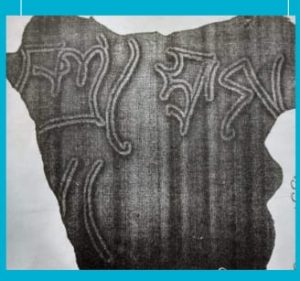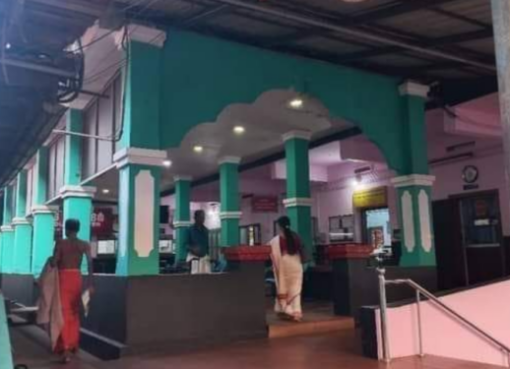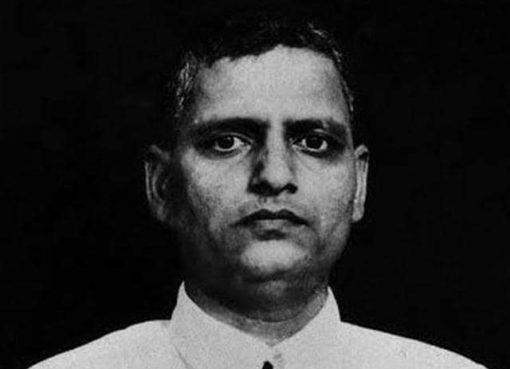-Sri Jyotishman Sarkar
It was indeed a tumultuous period and by AD 1379, Sikandar Shah launched a campaign against the Tamralipta kingdom, ruled by Bhangar Roy then. At this time the five feudal states under Tamralipta were Hijli, Kashijora, Mainagarh, Mahishadal and Turka respectively.[9] Nevertheless, the vicious armed campaign was braved and Haricharan Das Bhuiyan, the Kaivarta king of Hijli, led a mighty navy. The combined naval forces of Tamradhwaj and Hijli confronted Sikandar Shah’s forces near the port of Saptagram.[12] In the fierce battle ensued, Sikandar Shah’s forces were scattered. Saptagram was again liberated and came under the rule of Tamradhaj. Govardhana Das of the Hijli dynasty ruled Hijli until the Pathan invasion of AD 1505[10]
Now let’s focus on Hatiagarh and Banai River:
ডাহিনে অনেক গ্রাম রাখে সাধুবালা ।
ছত্রভোগে উত্তরিল অবসান বেলা ।।
ত্রিপুরা পূজিয়া সাধু চলিল সত্ত্বর ।
অম্বুলিঙ্গে গিয়া উত্তরিল সদাগর ।।
নীলমাধব পূজা করেন তৎপর ।
তাহার মেলানি সাধু পাইলেন ” হেতেঘর “।।
সেই দিন সদাগর হেতেঘরে রয় ।
রজনী প্রভাত করি মেলি সাত নায় ।।
— কবিকঙ্কণ চণ্ডী [11]
Where is Hathiagarh then?
Well, Heteghar has been mentioned by illustrious Bengali poet Kavikankan in ChandiMangal. This town of Hatiagarh belonged to the ancient Burdwan Bhukti in the Banai river basin on the west bank of the Adi Ganga (flowing once). This independent township consists of five undivided Garh (গঢ়)
When the legendary Sena reign ended finally, lower Bengal got divided into several independent territories or janapadas. These independent towns resisted the Muslim invasion through fierce fighting for decades and one of them was Hatiagarh.
In accordance with Sri Devi Shankar Midya, noted antiquarian and also researcher on the history of Sundarban, “The first of these was at what is now called Shingulbede, the second at Chandipur, the third at Chhatrabhoga in Barashi, the fourth at Durganagar and the fifth at Panduli Bari i.e. Srinarayanpur. This fifth fort is famous as Hatiagarh. The discoverer of Sundarban’s history, Kalidas Dutta mentioned the location of Hatiagarh fort in his map of Adigangas. Its massive ruins still exist today.”
Now, in 14th century AD, the king of Hatiagarh town was Mahidananda of Naga descent. He was most likely a vassal of King Chandraketu Sen. He left the country in the hands of his two heroic sons, Akananda and Bakananda, and spent his days in the Saiva Math of Barashi. Although he was a Shaiva, he also respected Vaishnavs a lot.
Inscriptions & Other antiquities:
Architectural remains, bricks inscribed with flowers and inscriptions, several Vishnu idols, Harihara idols, and a few stone Shivalingas have been found in the area adjacent to the Hatiagarh ruins.
 A huge stone Shivalinga found inside Hatiagarh was brought up by the local Dhibaras and installed in the nearby village of Kantabenia and is still worshiped in this village. Two inscribed seals recovered from the ruins, one with the words “Shri Snag/ শ্রী স্নাগ” and the other with the Sena Yugiya Samvat.
A huge stone Shivalinga found inside Hatiagarh was brought up by the local Dhibaras and installed in the nearby village of Kantabenia and is still worshiped in this village. Two inscribed seals recovered from the ruins, one with the words “Shri Snag/ শ্রী স্নাগ” and the other with the Sena Yugiya Samvat.
Campaign of Abbas Ali:
Mahidananda’s eldest son Akananda was in charge of Shingulbede and Chandipur forts. His younger brother Bakananda guarded the forts of Hatiagarh and Durganagar.
Fourteenth century AD. Starting from far away Makkah, he visited various places and brought 21 walis and other mercenaries (21 walis means 21 regiments of 21 pirs) along with Hazrat Syed Abbas Ali Razi.
Abbas Ali Razi came to Raikola village in Lower Bengal to spread Islam in Bengal. Hazrat Syed Abbas Ali’s complexion was milky white. So the new Muslims of Bengal named him Gorachand, Gora Ghazi or Pir Gorachand.[4][5]
List of 22 Commanders:
- Mohammad Shah Sufi
- Dabab Khan agrees
- Hazrat Ahmadullah
- Hazrat Abdullah
- Dawood Akbar
- Safiqul Alam
- Hazrat Saeed
- Mohammad Hasan
- Mohammad Dayem
- Abdul Latif
- Abdullah Awal
- Hazrat Hameduddin
- Hazrat Abul Fazal Bazi
- Hazrat Momenuddin
- Korban Ali
- Hazrat Elias
- Syed Abdul Quader
- Abdun Naeem
- Abdul Ahed
- Hossain Haider
- Mohammad Fazil [4]
Chandraketugarh:
After the rule of Raja Dakshin Raya, some Sena kings extended their dominion over the Bhati region.
Under Raja Chandraketu Sen, Mahidananda of the Naga clan ruled the forts of Hatiagarh, Durganagar, Chhatrabhogge, Shingulbede, Chandipur.
According to folklore, he declared war when the Hindu subjects of Deuliya or Debalay Village had been forced to convert into Islam.[4]
Battle of Champatala:
Governor Sikander of Gaur led a war against King Chandraketu on the side of the Pathan warrior Pir Gorachand faught.The battle took place in the wilderness of Rankhela in Chappatla where King Chandraketu’s two favorites, Hama and Dama, practiced warfare.
When Chandraketu was going from the fort to city, some Muslim soldiers suddenly came out from some invisible place on the way and attacked him. It was night, he had no weapons suitable for war, the number of special attackers was high, so he got captured soon. Chandraketu, who was captured, belongs to Muslims. He shouted “Allah Allah”. Immediately it was seen that numerous Muslim soldiers had entered the fort.
Jaisena was entrusted with the defense of the fort. Seeing that the Muslims had entered the fort, Jayasena floated in the ocean with the infinite glory. It became very difficult for both the parties to choose the Buddha of the night. So whoever came forward, he started to cut him in two with such a sharp blade. How long did Jaisena die in the hands of the Muslims? King Chandraketu came close to winning the war.[7]
But a traitor sends false news to demoralize the townspeople. The townspeople were enraged and the queen drowned in Padmadah (পদ্মদহ) and committed suicide. When this news reached the king, the king lost his morale and accepted the defeat in the battle.The defeated king Chandraketu returned to the kingdom and sacrificed his life at Padmadaha. Gorai Ghazi (or Syed Abbas Ali) forcibly converted the subjects.[3]
Destruction of Balanda Mahavihara:
 Mahamahopadhyay Harprasad Shastri Mahasay wrote that” Nalanda was known throughout the world as a center of philosophy and science and Balanda Mahavihara was a center of Shakti Prajnaparamita (Manjushri) Buddhism. “[3]
Mahamahopadhyay Harprasad Shastri Mahasay wrote that” Nalanda was known throughout the world as a center of philosophy and science and Balanda Mahavihara was a center of Shakti Prajnaparamita (Manjushri) Buddhism. “[3]
At Balanda there was a Buddhist Vihara, the statue of Buddha, worshiped Dharma Thakur. Balanda’s Ekkhani Ashtasahsika Prajnaparamita is still in the Nepal Darbar Library.Even in the Pala Sen period This Buddhist monastery was intact.This Vihar was one of the centers of the Buddhists of South Bengal.[8][6]
After the victory in the battle of Chapatla, the people of this area were forcibly converted. In this region there was a famous Buddhist Mahavihara of the Palasen age, which was protected from invaders till then. The temple was built of red sandstone and bricks.
Abbas Ali and his soldiers destroyed that Buddhist monastery and built a mosque and named it ‘ Lal Masjid ‘.[4][2]
Attack on Hathiagarh:
Gorai Gazi heard about Hatiagarh there after the victory without a fight. He heard the bravery of Akananda and Bakananda.Gorai Gazi set off for Hatiagarh with his companions. A war broke out with Akananda and Bakananda. Several Muslim poets wrote poems and stories about this war story in the 18th century and later.
Sufi Shah Imanuddin, Munsi Niamatullah, Mohammad Ebadollah, Ketabddi Miya are notable among them.A young man named Abdul Jabbar Haldar of Beluni village gifted this researcher with his written poem about Gorachand. Let’s listen to the story of Aka-Baka’s war from the perspective of these poems.
গোরাচাঁদ একদিল রহিল অনেক দূর।
গোরা গেল বালাণ্ডায়, একদিল আনারপুর।।
Gorai Gazi wants to go to ‘Hatiagarh’. But his mother was promised that he would not go to ‘Henteghar’ —
‘’ হেতেগড়ে যায় না গোরা মা দিয়েছে বাধা ।
হেতেগড় যায় না গোরা আছে হারামজাদা ।।
Description of Battle in the script (পুঁথি):
But Gorachand heard Akananda’s exultation—
‘নাম আমার আকানন্দ
বাকানন্দ আমার ভাই পেয়েছি শিবের বর
রোজ করি মানুষ আহার ।
মজবুত শক্ত দেহ যার খুশি আসুক কেহ
দেখাইব মজা তাহার ।।’
Gorachand could not bear the pride. After that, Gorachand initiated forceful conversion of many local people into Islam and advanced further south. He left the horse and went to Hatiagarh. First came to BelluniAkananda lives there in the fort of Shingulber. Pir said to Akananda with a sigh–
‘ শিঙ্গুলবেড়ের দেউলেতে কর্ম জমিদারি ।
ঘর পিছু কর খাও , দেশ থরহরি ।। ‘
Battle of Barasir:
And he said, accept Islam. Sin will be free, you will be forgiven. But Akananda did not agree. Fierce war between the two sides –
‘ আকানন্দ বাকানন্দ রাবনের শালা ।
তার সঙ্গে যুদ্ধ হৈল অষ্ট প্রহর বেলা ।।'[4]
Gorachand had a brother named Sahachand. He brought soldiers and ambushed Barashi fort. Raja Mahidananda, the old ruler of Hatiagarh, lost his life in the war. Bakananda was shocked to hear the news of his father’s death.
‘ কাঁদে বাকানন্দ রায় , কেবল মুখে হায় হায় ।’
Minister advised him ,
‘যাও তবে বড়াশীর মঠে
থাকে শিব সেই ঘটে
ভোলানাথ গুরু কল্পতরু
আছে তাঁর বান ষোল যুড়ি
সেই বানে গোরার ভাঙবে জারিজুরি । ‘
Bakananda ran after his father. There, he called in the name of Shiva and took possession of Sixteen Pairs of Arrows. The Hari, Kaura, Barga Kshatriya, Pundra soldiers started fighting again with renewed enthusiasm.
Battle of Second Day:
The war started again. The water of Banai river turned red in the fierce battle. Bankananda had his final battle with Gorachand and at the end of the battle he fell half dead by Bankananda.Then he threw the bun given by Shiva on Gorachand —
আকনের সঙ্গে যুদ্ধ হইল হেনকালে।।
আকানন্দ বাকানন্দ রাবণের শালা।
তার সঙ্গে যুদ্ধ হইল আড়াইপক্ষ বেলা।।
কি জানি আল্লার মর্জি নসিবের ফের।
চেকোবাণে গোরাচাঁদের কাটা গেল ছের।[4]
Gorai Ghazi kept running away in a crocodile-shaped boat on the Banai River with his neck cut. Banai suddenly swelled up. His calm chest waved like a palm tree. Gorai fell on the bank of Banai. Gorachand continued to make mistakes during his death. Banai kept cursing the river—-
‘ চাওট পড়ে হবি কুঁড়ে না থাকিবে বল ।
জোয়ার ভাটা হবে বন্ধ যাবি রসাতল ।।
চাষীজন তোর বুকে জন্ম দেবে ধান ।
It means that you will go and have fun and you will have fodder and rice cultivation.Bankananda’s final battle with Gorachand was fought on the banks of Banai river and after the battle he fell half killed by Bankananda.[2]However, the main stream of the Sundarbans, the Adiganga, has been diverted. Numerous rivers have disappeared. But Banai still survives today.
However, the navigability of the river has decreased. The place is in the eastern part of Kendo Ramchandrapur of Dhola thana. A little further, the stream of Banai is flowing into the canal. The canal is quite large in width. There are numerous Karanja, Bine, Havel trees on the banks. Salt water flow still comes. Several years ago the tide played.
Muslims believe it is due to Gorachand’s curs Wounded Gorachand was brought to Balanda. He said—
‘ ক্ষতস্থানে দাও পান সুরকি লাগাইয়া ।
এখনি দেখিবে সব আল্লারই দোয়া ।।’
But no one could find anything. No one in Balanda gave even a drop of lime or Betel leaves to the tyrannical Muslim rulers. Gorai Ghazi died in Bargoppur on 12th Falgun Balanda in 1373 AD. [2] Even today there are some memories of Banai.[4]
A gop called Kalu Ghosh buried Abbas Ali. [1] This area was earlier a gop chief. All these Gopas were converted in the Middle Ages under Muslim influence. Later under the influence of Aulchand’s reform movement. A large section of Nadia’s Gopas reverted to Hinduism.
There are ruins of Hatiagarh fort. Shiva of Barashi is now in Bijaypur. Even today in some houses of Beluni village, Muslim girls read Gorachand’s punthi in the evening.
Although now Dveganga is a Muslim predominance, it was not so in the past.
“যত প্রজা ছিল তথা সবে হিন্দুয়ান ।
সেখানেতে নাহি ছিল এক মছলমান।”[2]
The Bengala statue called “Vasuki-Kulgatha” shows that the Senas founded the city.
ভাগীরথী নদীতীরে দীর্ঘ গঙ্গা গ্রাম
সৰ্ব্বস্থানে দ্বিগঙ্গা বলিয়া ঘুষে নাম ।[2]
But the fighting spirit of Akananda – Bakananda did not find a place in any history text. [1]
Sources:
1) বাংলায় ভ্রমণ প্রথম খণ্ড 45/46 page
2) History of Jassore Khulna Satish Chandra Mitra (যশোর খুলনার ইতিহাস সতীশচন্দ্র চন্দ্র মিত্র) vol 1,164,186,187,201,398, 442 page
3) Haraprasad Sastri Rachana Samagra Vol 2 [হরপ্রসাদ শাস্ত্রী রচনা সংগ্রহ (দ্বিতীয় খণ্ড).] 246,289,290 page
4) 4.Bqngla Pir Sahitter Kotha Girindra Nath Das (বাংলা পীর সাহিত্যের কথা ডঃ গীরিন্দ্রনাথ দাস )111 ,114, 140 page
5) Pir Kahani Muhammad Ebadollah (পীর কাহিনী মুহাম্মদ এবাদুল্লাহ)
6) 6.অতীতের হাড়োয়া- মোঃ আব্দুল জব্বার
7) 7.Chadraketu Kedarnath Chakraborty (চন্দ্রকেতু কেদার নাথ চক্রবর্তী) 120 page
8) ৪.দক্ষিণ ২৪ পরগণার পুরাকথা কৃষ্ণকালী মন্ডল 71,72 page
9) 9.গৌড়ের ইতিহাস – রজনীকান্ত চক্রবর্তী Pp- 203-4
10) 10.বৃহত্তর তাম্রলিপ্তের ইতিহাস-Yudhishir Jana Page 262
11) 11.Kabikankan Chandi Mukundram Chakraborty (কবিকঙ্কণ চন্ডী মুকুন্দরাম চক্রবর্তী) Ed 2
12) 12.Burdwan: History & Culture Jagweswar Choudhury , 2nd part (বর্ধমান ইতিহাস ও সংস্কৃতি) pp 74
(Host of information in this article is taken from – ‘Sundarban Prathna Gabeshona Kendra’ Facebook page),







Comment here
You must be logged in to post a comment.